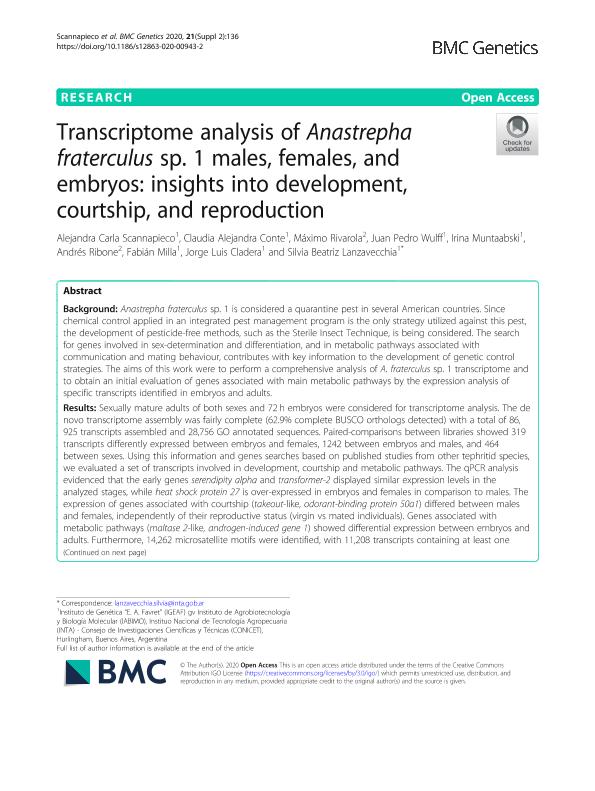Artículo
Transcriptome analysis of Anastrepha fraterculus sp. 1 males, females, and embryos: insights into development, courtship, and reproduction
Scannapieco, Alejandra Carla ; Conte, Claudia Alejandra
; Conte, Claudia Alejandra ; Rivarola, Maximo Lisandro
; Rivarola, Maximo Lisandro ; Wulff, Juan Pedro
; Wulff, Juan Pedro ; Muntaabski, Irina
; Muntaabski, Irina ; Ribone, Andrés Ignacio
; Ribone, Andrés Ignacio ; Milla, Fabian Horacio; Cladera, Jorge Luis; Lanzavecchia, Silvia Beatriz
; Milla, Fabian Horacio; Cladera, Jorge Luis; Lanzavecchia, Silvia Beatriz
 ; Conte, Claudia Alejandra
; Conte, Claudia Alejandra ; Rivarola, Maximo Lisandro
; Rivarola, Maximo Lisandro ; Wulff, Juan Pedro
; Wulff, Juan Pedro ; Muntaabski, Irina
; Muntaabski, Irina ; Ribone, Andrés Ignacio
; Ribone, Andrés Ignacio ; Milla, Fabian Horacio; Cladera, Jorge Luis; Lanzavecchia, Silvia Beatriz
; Milla, Fabian Horacio; Cladera, Jorge Luis; Lanzavecchia, Silvia Beatriz
Fecha de publicación:
12/2020
Editorial:
BioMed Central
Revista:
BMC Genetics
ISSN:
1471-2156
Idioma:
Inglés
Tipo de recurso:
Artículo publicado
Clasificación temática:
Resumen
Background: Anastrepha fraterculus sp. 1 is considered a quarantine pest in several American countries. Since chemical control applied in an integrated pest management program is the only strategy utilized against this pest, the development of pesticide-free methods, such as the Sterile Insect Technique, is being considered. The search for genes involved in sex-determination and differentiation, and in metabolic pathways associated with communication and mating behaviour, contributes with key information to the development of genetic control strategies. The aims of this work were to perform a comprehensive analysis of A. fraterculus sp. 1 transcriptome and to obtain an initial evaluation of genes associated with main metabolic pathways by the expression analysis of specific transcripts identified in embryos and adults. Results: Sexually mature adults of both sexes and 72 h embryos were considered for transcriptome analysis. The de novo transcriptome assembly was fairly complete (62.9% complete BUSCO orthologs detected) with a total of 86,925 transcripts assembled and 28,756 GO annotated sequences. Paired-comparisons between libraries showed 319 transcripts differently expressed between embryos and females, 1242 between embryos and males, and 464 between sexes. Using this information and genes searches based on published studies from other tephritid species, we evaluated a set of transcripts involved in development, courtship and metabolic pathways. The qPCR analysis evidenced that the early genes serendipity alpha and transformer-2 displayed similar expression levels in the analyzed stages, while heat shock protein 27 is over-expressed in embryos and females in comparison to males. The expression of genes associated with courtship (takeout-like, odorant-binding protein 50a1) differed between males and females, independently of their reproductive status (virgin vs mated individuals). Genes associated with metabolic pathways (maltase 2-like, androgen-induced gene 1) showed differential expression between embryos and adults. Furthermore, 14,262 microsatellite motifs were identified, with 11,208 transcripts containing at least one simple sequence repeat, including 48% of di/trinucleotide motifs. Conclusion: Our results significantly expand the available gene space of A. fraterculus sp. 1, contributing with a fairly complete transcript database of embryos and adults. The expression analysis of the selected candidate genes, along with a set of microsatellite markers, provides a valuable resource for further genetic characterization of A. fraterculus sp. 1 and supports the development of specific genetic control strategies.
Archivos asociados
Licencia
Identificadores
Colecciones
Articulos (IABIMO)
Articulos de INSTITUTO DE AGROBIOTECNOLOGIA Y BIOLOGIA MOLECULAR
Articulos de INSTITUTO DE AGROBIOTECNOLOGIA Y BIOLOGIA MOLECULAR
Citación
Scannapieco, Alejandra Carla; Conte, Claudia Alejandra; Rivarola, Maximo Lisandro; Wulff, Juan Pedro; Muntaabski, Irina; et al.; Transcriptome analysis of Anastrepha fraterculus sp. 1 males, females, and embryos: insights into development, courtship, and reproduction; BioMed Central; BMC Genetics; 21; 12-2020; 1-166
Compartir
Altmétricas



